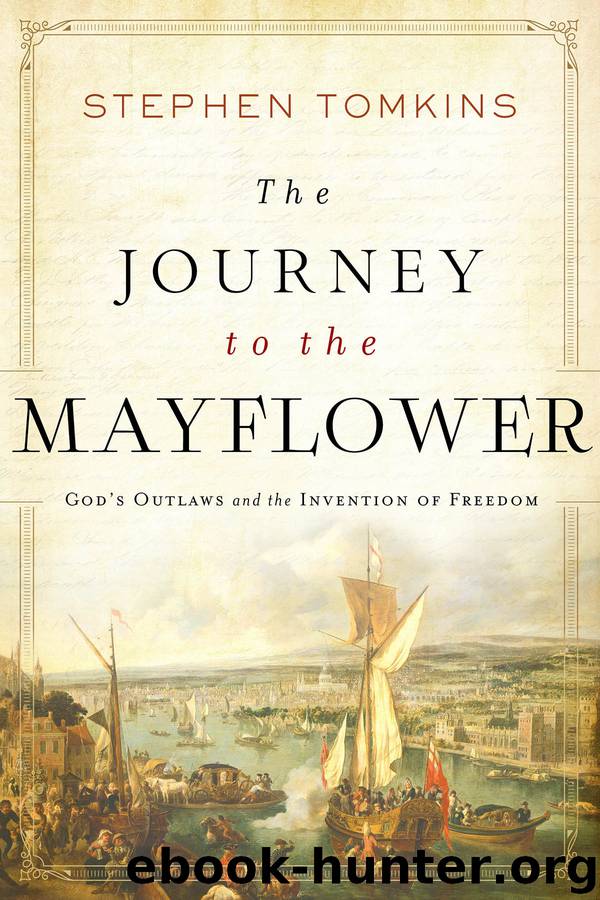The Journey to the Mayflower by Stephen Tomkins

Author:Stephen Tomkins
Language: eng
Format: epub
Tags: Epub3
Publisher: Pegasus Books
17
A Brief Discoverie
HAVING ALREADY PROVED that close imprisonment and being forbidden pen and paper were not going to stop him publishing books, late in 1590 Barrow excelled himself, writing a huge book, 264 pages long when printed, which he saw fit to call A Brief Discoverie of the False Church. He passed each page as he wrote it to Daniel Studley, a Separatist girdler who had permission to visit, and Studley took them to the physician James Forrester, who was paid to make fair copies for the printer – perhaps Barrow’s excuse for the title is that by the time he finished the book it was too late to change it. Forrester was dismayed by the ‘sharp style’ of the book, quit the church and became a vociferous opponent of Brownism. The manuscript was smuggled to Dort, perhaps by Scipio Bellot, the brother of Arthur, and it was printed there from December to February 1591.
A Brief Discoverie starts with a survey of church history. All Protestants agreed that the church had gone wrong at some point, in order to require reformation, and the more radical their reformation the further back they had to trace the fall of the church. Barrow, like the Anabaptists, went all the way back to the first generation after the apostles, as soon as the Bible was complete. Believers started venerating their leaders, he said, abdicating their freedom and responsibility to understand and teach and organise for themselves. The leaders succumbed to pomp, power and superstition; ‘then were these called bishops’. Hierarchy developed as they took more and more power, until the diocese of Rome went from being supported by the Roman Empire, to being ‘mixed with the Empire, and in the end swallowing it up’. Thus Rome ‘became the very throne of antichrist . . . to whom the key of the bottomless pit was given’. Throughout the centuries there was always a tiny remnant of true believers who ‘had the light in the midst of these hellish fogs’. The scriptures were clear, Barrow said, that, in his own day, the judgement of God was about to fall on the false church; God was waiting only ‘till his ark be built’ – which is the true, separated church – and till the full number of his chosen ones had entered it.1
This took Barrow on to the question of how to tell the true church from the false, much of his answer reiterating the arguments that had been the focus of his writing to date. But he went beyond into new ground, opposing and correcting Calvin’s understanding of the church.
The Separatists had always until now presented themselves as the true upholders of Reformed Christianity in England. On questions from vestments to episcopacy, the Church of England was out of line with its foreign brethren, embracing corruptions that other churches rejected. The problem with this stance was that Barrow, like Browne before him, had come to understand the church in a radically new way: not as a
Download
This site does not store any files on its server. We only index and link to content provided by other sites. Please contact the content providers to delete copyright contents if any and email us, we'll remove relevant links or contents immediately.
Angels by Billy Graham(1886)
How To Be Born Again by Billy Graham(1731)
Peace with God by Billy Graham(1643)
Unbroken Curses by Rebecca Brown & Daniel Yoder(1519)
God's Prophetic Symbolism in Everyday Life by Adam Thompson & Adrian Beale(1446)
The School of Biblical Evangelism by Ray Comfort(1392)
Call by Rick Joyner(1364)
Martin Luther: The Man Who Rediscovered God and Changed the World by Eric Metaxas(1353)
Power over the Enemy by John Osteen & Joel Osteen(1315)
Jonathan Edwards: A Life by Marsden George M(1195)
Fresh Wind, Fresh Fire by Jim Cymbala(1191)
Prayers That Bring Healing and Activate Blessings: Experience the Protection, Power, and Favor of God by John Eckhardt(1188)
Liturgy of the Ordinary by Tish Harrison Warren(1182)
The Supernatural Power of a Transformed Mind Expanded Edition: Access to a Life of Miracles by Bill Johnson(1172)
Unmasking the Devil: Strategies to Defeat Eternity's Greatest Enemy by John Ramirez(1162)
An Altar in the World by Barbara Brown Taylor(1154)
Reformation Theology by Littlejohn Bradford(1146)
Seeing the Voice of God: What God Is Telling You through Dreams and Visions by Smith Laura Harris(1103)
Martin Luther by Mansch Larry D.; Peters Curtis H.;(1102)
